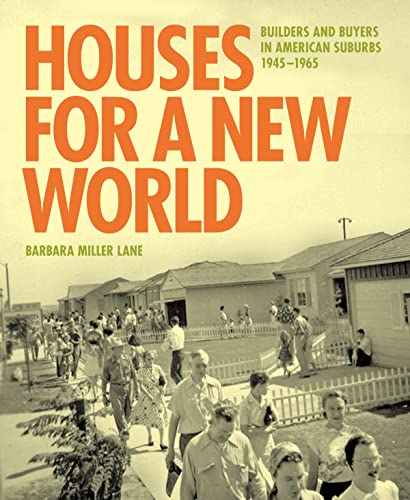Houses for a New World
Builders and Buyers in American Suburbs, 1945-1965
Barbara Miller Lane
BOOK REVIEW

In the aftermath of World War II, America underwent a seismic shift that redefined communities, lifestyles, and the very notion of home. Houses for a New World: Builders and Buyers in American Suburbs, 1945-1965 by Barbara Miller Lane unearths the layers of this transformation, digging deep into how the American dream of homeownership manifested in the burgeoning suburbs. This is not just a book; it is a nostalgia-laden portal to a time when aspirations and architectural ambitions collided.
From the ashes of war, a new America emerged, and with it, the suburbs became both a refuge and a canvas for growth. Lane meticulously chronicles the saga of builders and buyers, revealing how suburban development was not merely about constructing houses but creating a culture. It's a compelling exploration of the aspirations of everyday Americans-how they sought safety, community, and comfort after years of chaos. You can almost hear the laughter of children on quiet streets, the frenzied discussions about landscaping, and the electrifying whispers of dreams shared across backyard fences.
You might find yourself captivated not only by the houses themselves but by the stories of those who inhabited them. Lane's prose weaves personal narratives with broader historical contexts, illustrating how the ideal of the American home was intricately linked to notions of identity, freedom, and the promise of prosperity. This book isn't just a recount of bricks and mortar; it's a rich narrative that invites you to acknowledge the powerful emotions behind these structures. The longing for one's slice of the American dream pulsates through every chapter, invoking a deep sense of empathy and connection.
Critics laud Lane's ability to challenge prevailing narratives about suburbanization, going beyond the typical tropes of conformity and discontent. Readers have praised her balance of scholarly research and approachable storytelling, making complex historical dynamics digestible for everyone-from the casual reader to the history buff. Yet, caught in the delight of discovery, some have argued that she may romanticize this chapter of American history. After all, burgeoning suburbs also gave rise to social issues, such as racial segregation and the stark contrasts of wealth.
This duality is fascinating and highlights the complexities of the era. Lane doesn't shy away from discussing the darker aspects of suburban growth, including the exclusionary policies that dictated who could live in these new developments. The reader is confronted with the jarring reality that the pursuit of happiness often came at a steep cost to marginalized communities. This profound examination reminds us that the walls of a house can also encapsulate societal inequities and unfulfilled dreams.
The book urges you to reflect on what "home" means in a broader context. After diving into Lane's work, you may find yourself reevaluating your own concept of home-its shape, its history, and its impact on identity. As you navigate through the pages, it becomes clear that your relationship with your living space is imbued with cultural significance that traces back to the suburbs of the mid-20th century.
Those who have taken the plunge into this text have emerged enlightened, often expressing how Lane's insights challenge their preconceived notions of suburbia. One reader remarked, "I never realized how much our modern suburban landscape is the product of historical forces-this book changed my perspective completely." Lane has sparked discussions that ripple far beyond the pages of her narrative.
So, whether you are an architecture enthusiast, a social historian, or someone caught in the hustle of modern suburban life, Houses for a New World beckons you to delve deeper. It's an exploration infused with passion and poignancy, pulling you through decades of cultural evolution while compelling you to reckon with the implications of the American suburban ideal. The story of these houses is your story-shackled to the dreams and disappointments of those who sought solace and identity within their walls.
To miss out on this book is to miss out on understanding a significant chapter of American history-a chapter that continues to echo in the neighborhoods we navigate today. So, immerse yourself in this journey, and witness how Lane transforms the mundane into the profound through the lens of the homes that shaped a generation. Your perspective on home, community, and identity will never be the same again.
📖 Houses for a New World: Builders and Buyers in American Suburbs, 1945-1965
✍ by Barbara Miller Lane
🧾 320 pages
2015
#houses #world #builders #buyers #american #suburbs #19451965 #barbara #miller #lane #BarbaraMillerLane